For Home Inspectors: Evaluating Problems with Fasteners
The term "fasteners" typically refers to nails, screws, bolts, and sometimes anchors. Fasteners may directly join together two pieces of material, or the material may be held together by connectors that are, in turn, held in place by fasteners. A good deal of the difficulty in evaluating fasteners is the fact that most home inspectors inspect existing structures, as opposed to homes under construction, so, by the time the inspector sees a fastener, there’s usually not much visible except its head. Certain problems affecting fasteners, such as corrosion, may be visible, but other problems may be apparent only to inspectors who understand their properties and those of the materials they join. In addition to becoming aware of visible issues, inspectors should understand some of the basics about fasteners that will help them spot less obvious problems.
Anchors are receptacle devices installed in very soft or very hard materials that alone wouldn’t hold or accept nails, screws or bolts well.
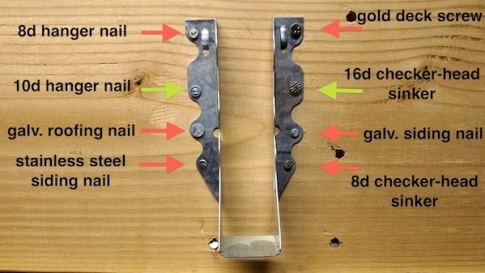
some of which are correct for this particular connector, and some of which are not.
- the types and extent of the force the fastener must resist;
- the properties of the materials into which the fastener will be driven;
- the various environmental elements that will act upon the fastener during its lifespan; and
- the fastener’s lifespan requirements.
STRUCTURAL FORCES
Fasteners are designed to resist two structural forces: withdrawal and shear.
Withdrawal
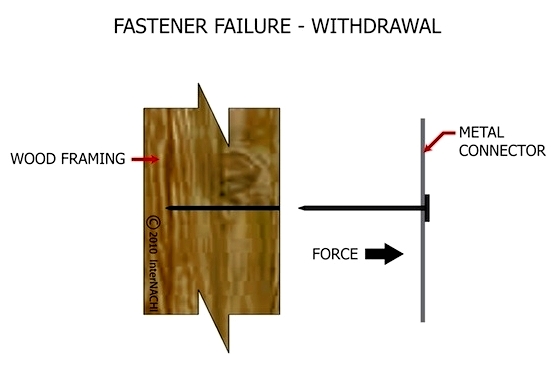
The withdrawal force is parallel to the shaft of the fastener, called the shank. If you were to grab the head of a screw or nail with a pair of pliers and try to pull it straight out, the fastener would resist withdrawal.
One method used to help improve fastener resistance to withdrawal is to deform the fastener shank. This improves withdrawal resistance by increasing the friction that has to be overcome in order to withdraw the fastener.
Shank deformation takes a number of different forms. Adding threads to a fastener shaft to form a screw is one good way to achieve resistance.
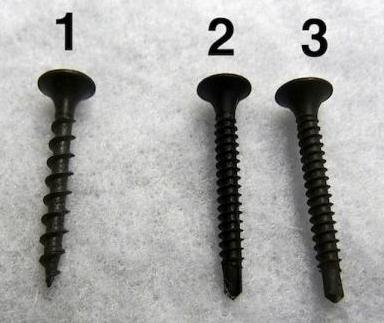
Drywall screws
#1 is a coarse-thread screw designed for use with wood studs.#2 is a self-drilling, fine-thread screw designed for use with light-gauge steel studs.#3 is a self-drilling, fine-thread screw designed for use with heavy-gauge steel studs.
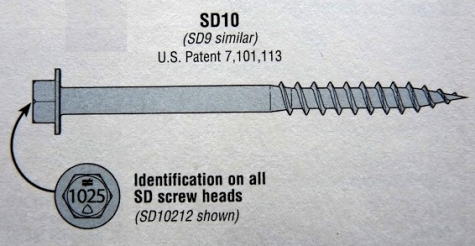
Simpson structural screw

The SD wood screw is not approved for use with metal connectors. The structural screw is.

Head markings for Simpson screws

The structural screw in the diagram above is made by GRK. The CEE thread is designed to enlarge the hole in the uppermost of two pieces being joined so that they’ll be more tightly pulled together.

Ring-shank nail
Another method used to resist withdrawal is to roughen the nail shank by adding a series of rings. These are called ring-shank nails.

Roughened shank
Yet another method is to roughen the shank with coatings. In the photo above, compare the hot-dipped galvanized nail to the uncoated (bright) nail. Rough coatings are usually added to resist corrosion, but resistance to withdrawal is an additional advantage.

A spiral shank can also help resist withdrawal,
although it’s one of the less common types of fasteners used in building construction.
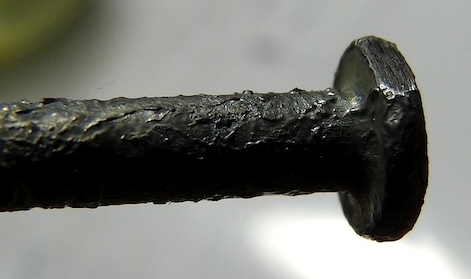
Head-shank connection
In addition to the properties of the fastener shank, the strength of the connection of the head to the shank and the thickness of the head are important in resisting withdrawal.
EXPERIMENTS
Inspectors should be aware of several experiments that have been conducted relative to withdrawal.
Gas & Wax
Before framing nails coated with vinyl became available in the mid-1970s, production framers working on large housing tracts in California found that uncoated nails took more of an effort to pound than they wanted to exert. So, to make nails easier to drive, they would toss a bar of paraffin wax onto an open 50-pound box of 16d nails, pour on a little gasoline, and touch it off with a match. The wax would melt down through the box, making the nails much easier to drive, but lowering their withdrawal resistance dramatically. It also made it easier for the framers to hold onto a wood-handled hammer in hot weather. Baby powder was occasionally poured into the open box of nails for the same purpose, but it didn’t work as well as a lubricant.
Shrunken, Roughened Shanks
In the early 1990s, in an attempt to save money, some framing contractors substituted a slightly smaller nail with a roughened shank for the industry-standard, 16d hand-driven framing nail. However, this can lead to unexpected nail pull-out during construction with disastrous and potentially dangerous results.
Both gas and wax and the smaller substitute nails were used on many homes in California and a number of other places during the ‘90s, so if you see structural failures related to nail withdrawal, including head parts that are merely glued in place to give the appearance of being nailed, one of these issues or something similar may be the source of the problem. But there are some things you just won’t be able to spot.
SHEAR
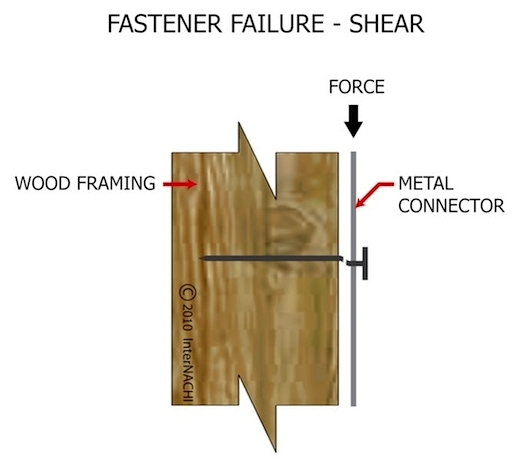
Shear force is exerted perpendicular to the shank of a fastener. Fasteners that fasten metal connectors to wood are primarily designed to resist shear, although, in many applications, there will also be some withdrawal force involved, too. That's why fasteners for connectors also have minimum length requirements. The properties important to resisting shear are the strength of the alloy from which the fastener is made, its diameter, and the strength of the connection between the fastener shank and its head.
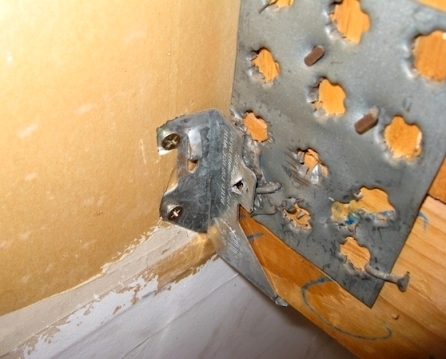
A defective installation
The fasteners used to connect the hanger to the wall pictured above are defective because the gold deck screws used are designed to resist withdrawal when holding deck planking to floor joists. They have inadequate shear strength to support the structural roof load. Also, because the drywall does not support the shank of the screw as adequately as wood does, the shear force is increased. Imagine that instead of resting against drywall, a ½-inch gap was left between the hanger and the framing. That’s almost the case. The roof of the garage next to this one collapsed under a snow load.

A similar defect with roofing nails
SCREW FAILURE
Screws fail in one of four ways:
- Failure occurs through the shank. An example of this occurs when driving screws into a hard material. Screws often snap off just below the head. Deck screws may appear to be securely in place when, in fact, the shank has snapped. Although it looks secure, the head is detached from the shank and the screw has no holding power. You might find this problem by pushing on the materials the screw is designed to join to see if they move separately.

- Stripping of the screw thread is common with a hard material and soft screw. The photo above was taken with an electron microscope and shows partially stripped threads.
- Stripping of the internally threaded material is common with hard screws and soft material. Consider the example depicting a screw going through a marshmallow (see below).
- The driver may strip the head. Slotted and Phillips-head screws strip more easily than screws with square or star drive profiles.

Square drive

Star drive

Screws used for fastening trim have heads smaller in diameter.
FASTENER LIFESPAN
The lifespan of a fastener is related to its base material, which is usually carbon steel or one of a couple of different types of stainless steel. The type and thickness of the coating or plating will also affect the lifespan, with zinc being one of the most common coatings. The lifespan will also be affected by the properties of the materials that the fasteners are joining together and the environment in which the fastener is used.
MATERIAL PROPERTIES
Density
Dense materials provide a better anchoring substrate for resisting both withdrawal and shear.
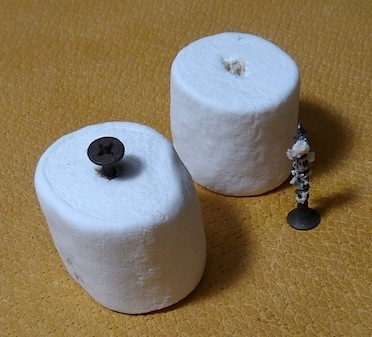
To use an extreme example, oak holds fasteners more effectively than marshmallows.
Dense wood may need to have pilot holes pre-drilled to prevent it from splitting, especially near the ends. Dulling the end of a nail also helps prevent splitting, since the dull nail point crushes through wood fibers instead of wedging them apart as a sharp point does.
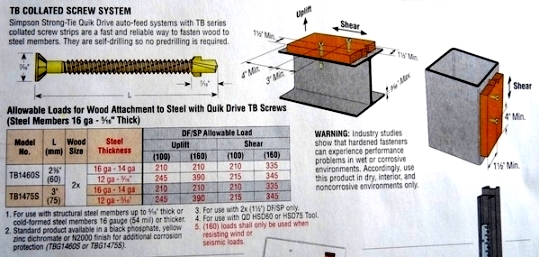
Some types of screws are designed to cut their own pilot holes.
This screw is designed to fasten wood to steel and will cut its own pilot hole through steel.
Some materials, such as plastic-based composites used for decking, vary in density according to temperature and moisture content, so fastening requirements can vary from day to day. Extreme expansion and contraction have also made fastening these materials a challenge. According to an article in the September 2007 issue of Building Products Digest magazine, there were about 750,000 decks built in 2006 using plastic composite planking.

A screw for fastening plastic-based composites
With as many as 80 manufacturers now offering composites of different formulations that are installed in widely differing climate zones, you may find decks with a large percentage of their fasteners that have spun out and have failed to hold the deck planking securely in place. Fastener manufacturers have been quick to provide solutions to these problems, and screws are now available for fastening composites used in a number of different environmental conditions.

In this illustration, you can see how the tips of various screw types are designed
to penetrate the materials that the screws were designed to fasten.
Thickness
Materials that allow a fastener to remain in contact along its full length will provide more effective anchoring than a thinner material through which most of the fastener has penetrated and is no longer in contact.

When thin materials, such as sheet metal, are joined together,
screws with fully threaded shafts are used.
When thicker materials, such as wood, are joined together, screws with a smooth section near the head allow the two pieces to be pulled tightly together.

This is a gold deck screw designed for fastening deck planking to joists.
CHEMICAL REACTIONS
Metal fasteners can lose their load-bearing capacity when exposed to corrosive environments and materials. These include:
- preservative-treated wood;
- ocean salt air;
- fire-retardants;
- fertilizers;
- fumes; and
- acid rain.
Part of learning the inspection profession is learning not just about common conditions that can affect fasteners, but about conditions unique to the local region where you work that may affect fasteners.
Preservative-Treated Wood
Several types of water-borne preservatives were used in the past to increase wood’s resistance to attack by wood-destroying insects and decay fungi. Each type included chemicals that corrode some metals. Chemical formulas vary by manufacturer and region, and those formulas may change without warning. The level of retention of preservatives can vary by wood species and by the method used to treat the wood. Complicating the issue even further is that the industry is still evolving. So, although fastener manufacturers make recommendations about compatibility with their products, choosing the correct fastener or confirming that the right fastener has been used can be difficult, especially if all you can see is the fastener head in the spot of a flashlight in a dark basement or crawlspace.
Chromated copper arsenate (CCA) was used for many years, but its use has declined due to the inclusion of substantial amounts of arsenic as one of the treatment chemicals. U.S. EPA regulations in place since 2004 call for pressure-treatment chemicals to be arsenic-free. Generally, hot-dipped galvanized and stainless steel are the recommended fasteners for CCA.
The next generation of wood preservatives commonly used in buildings includes alkaline copper quat (ACQ), copper azole (Types A and B), as well as SBX/DOT (sodium borate) and zinc borate (for wood composites). The formulations for these products also vary. Although they don’t contain arsenic, some types contain chemicals that are more corrosive to fasteners than CCA.
The recommended fasteners for these include hot-dipped galvanized, stainless steel, or triple-coated zinc polymer materials. Carbon steel and aluminum fasteners should be avoided. Aluminum nails are not common in building and, in general, their use is limited to fastening aluminum flashing, so watch for bright nails used with treated lumber, and comment on this if you find them.
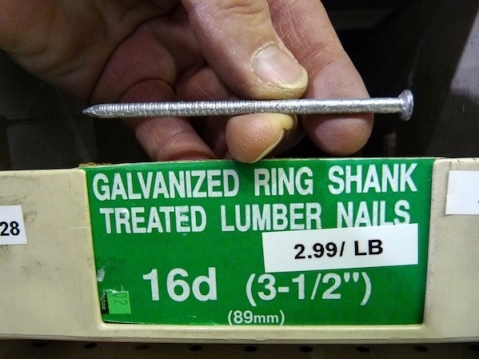
A nail approved for used with treated lumber
Most stainless-steel fasteners are acceptable for use with pressure-treated wood. Testing has shown that Types 304 and 316 stainless steel perform well with CCA-C, ACQ-C, ACQ-D carbonate, CBA-A, and CA-B treated woods.
The large number of variables that affect the rate of corrosion of fasteners in contact with pressure-treated wood makes it impossible to provide an accurate, estimated long-term service life for these fasteners.
PROTECTIVE COATINGS
There are two basic types of corrosion-protection methods used to protect steel-based fasteners. Barrier coatings bond to the steel and serve as a shield between the steel and the corrosive elements in the environment. Sacrificial coatings often serve as a barrier coating. Additionally, because they’re lower on the anodic chart, they will corrode before steel so that even if the protective coating is damaged, exposing the steel, the sacrificial coating will corrode first, protecting the steel base metal.
Bright
Steel fasteners with no protective coating are called bright fasteners. Bright fasteners should be used in low-corrosive environments only. Even humid air will cause any exposed portions to eventually rust.
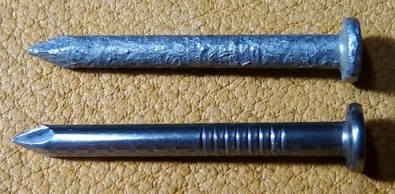
A hot-dipped galvanized hanger nail above a bright hanger nail
Galvanization
Fastener galvanization is the approved coating process most commonly used with pressure-treated lumber. Galvanization is the process of coating fasteners with zinc. The zinc coating acts as both a barrier coating, preventing corrosive agents from reaching the underlying steel base metal, and as a sacrificial coating, because zinc, as the more anodic metal, will corrode before steel. There are several types of galvanization processes, including hot-dipped, electroplated and mechanically galvanized. The thicker the galvanized coating, the longer the expected long-term service life of the steel fastener.
Hot-dipped galvanized fasteners are used in regions where a maximum amount of protection is desired. To hot-dip galvanize steel fasteners, the steel is first cleaned, pickled, fluxed, and then dipped in a molten bath of zinc. The fasteners are allowed to cool prior to inspection and shipping. Some concrete anchors and metal connectors can also be hot-dip galvanized. Hot-dipped fasteners are manufactured to ASTM 153 standards.
Electro-galvanized fasteners are used in mild-weather conditions and in areas with low humidity. Electro-galvanization plates the nail in a zinc coating by using an electrical charge. The nails are submerged into an electrolytic solution and an electrical current coats them with a thin layer of zinc. However, after prolonged exposure to the elements, the thin layer of zinc oxidizes, leaving the fastener subject to normal rusting and staining.

A hot-dipped roofing nail is shown on the left, and an electroplated roofing nail is shown on the right.
Mechanical galvanizing is a process of providing a protective zinc coating over bare steel. The bare steel is cleaned and loaded into a tumbler containing non-metallic impact beads and zinc powder. As the tumbler is spun, the zinc powder mechanically adheres to the parts. The coating of mechanically coated nails is porous and brittle compared to electroplated and hot-dipped fasteners and is prone to flaking off.

Two zinc-coated screws
Zinc-based coatings are one of the most common. Gold deck screws have undergone chromate conversion, which gives them their yellowish color. Cadmium screws were used in the past because of their strength, but due to cadmium's toxicity, it’s no longer used in fasteners that are typically used for building.
Vinyl-Coated Nails

A 16d vinyl-coated checker-head sinker, which is the industry standard
Framing nails manufactured today are coated with vinyl, which acts as a lubricant when the fastener is being driven. It also provides a small amount of barrier protection against corrosion. It’s a common coating on hand-driven framing nails, such as 8d and 16d sinkers.
Resin-Coated Nails
Some nails are coated with a resin that acts as a lubricant for easier driving, and also as an adhesive. Driving the nail raises the temperature of the fastener enough to liquefy the resin. Once in place, the resin hardens and acts as an adhesive, bonding the shank to the wood fibers.
Phosphate-Coated Nails
Adding a thin coat of phosphate helps resist withdrawal and also provides a small measure of resistance to corrosion.
Galvanic Corrosion
Galvanic corrosion occurs when certain dissimilar metals come into contact with each other. Two conditions must exist for galvanic corrosion to take place:
- There must be two dissimilar metals present.
- There must be an electrically conductive path between the two metals, such as water.
This means that fasteners used with metal connectors or flashing should be made of the same metal as the connector. For instance, using stainless steel fasteners with galvanized steel connectors will likely lead to corrosion.
Corrosion-Resistant Fasteners
Other types of corrosion-resistant fasteners include stainless steel Type 304 and especially Type 316, which are the industry standards for fasteners used in building construction. Type 316 is recommended for salt environments, but you won’t be able to tell just by looking.

The photos above and below show stainless steel fasteners.

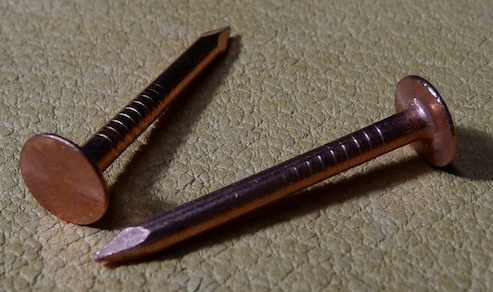
Copper nails resist corrosion well and are often used with copper trim
and to attach slate roof tiles.
Many commonly used construction materials, such as wood, expand and contract with changes in moisture content. This process is called moisture cycling. Over the long term, moisture cycling causes the holes around fasteners to enlarge, and when the fasteners used are nails, they eventually loosen in their holes and increasingly protrude as moist wood expands, gripping the nails and forcing them up and out of their holes slightly. As the wood dries, the holes enlarge, and the wood shrinks away from the nails.
As this cycle is repeated, nails can be raised above the wood surface significantly. Protruding nails are a common problem on decks with wood planking. This condition is also common on metal roofs with exposed fasteners, including screws.
FASTENER SIZES

Screws are sized by number. This is a self-tapping, hex-head #10 zinc-plated screw.

Nails are sized by the “penny” shown as a “d.”
This photo shows a 16d or 16-penny vinyl-coated checker-head sinker.
MASONRY ANCHORS
Mechanical Anchors

Masonry wedge anchor
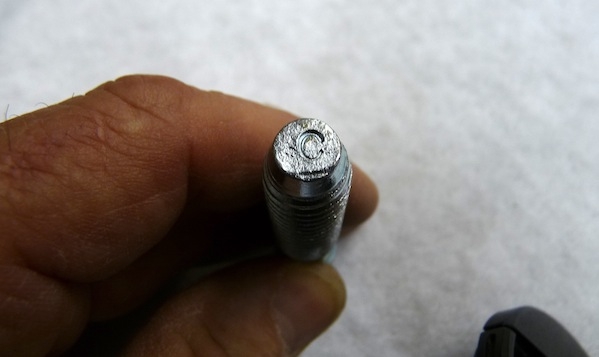
A wedge anchor code mark

The code table

Although you may see other fasteners with codes stamped into their heads like this stainless steel screw, codes are not standardized, so don’t assume you can tell the length by using the same chart that’s used for wedge anchors.

Anchoring in cracked concrete has been a problem in the past,
but a new type of wedge anchor is available for this use.
It’s the anchor on the left in the photo above.
Other Types of Concrete Anchors

Hammer drive

T-anchor
Bear in mind that concrete anchors don’t work well in concrete masonry units (CMUs), commonly called concrete blocks, unless the cells are filled.
Testing Anchor Connections
Manufacturers of masonry anchors recommend confirming that the anchors are properly installed by testing them to the proper torque using a torque wrench. They do not recommend tapping anchor heads with hammers or tightening them with a socket wrench.
Adhesive Anchors
Adhesive anchors are usually threaded steel bar (commonly called all-thread) or re-bar that’s inserted into pre-drilled holes and held in place with an adhesive. The manufacturer’s instructions should be carefully followed for the anchors to attain their full strength. Holes should be drilled to the correct depth and diameter and then brushed and blown clean with compressed air.
Adhesive formulations can vary, resulting in widely differing performance characteristics among products with similar chemistry, including temperature-related performance. One problem with adhesive systems is known as “creep.” Some types of adhesives are designed to resist short-term loads only, such wind and seismic loads. When subjected to long-term loads, anchors will slowly pull loose.
In Boston in 2006, a portion of a suspended concrete ceiling system in a tunnel collapsed, killing one person. The adhesive anchors holding the ceiling in place, which were subjected to a long-term gravity load, pulled loose, resulting in the collapse. If you inspect structures that may have adhesive anchors under long-term loads of some type, look carefully for signs of failure. One location where you might expect to see this in residential construction is where a concrete patio or porch has been retrofit to connect to a masonry foundation. Poor soil consolidation beneath the porch or patio slab that has resulted in settling may create a load on the anchors.
Concrete anchors have two test standards for creep, including the CC-ES AC 58, with the optional creep test. The other test is ICC-ES AC 308, which requires two sample tests taken at different temperatures.
DRYWALL ANCHORS
Different types of devices are available for anchoring screws into drywall. Some of the more common ones are shown below.




BOLTS

A typical zinc-plated, hex-head bolt
Two standards exist for grading bolts: the American National Standards Institute (ANSI) standard is for bolt strength. The International Standards Organization (ISO) standard is for both tensile and yield strength of the bolt.


A bolt graded by the ANSI standards is identified by
the number of lines arranged around the head of the bolt.
- 0 lines = Grade 2 tensile strength
- 3 lines = Grade 5
- 5 lines = Grade 7
- 6 lines = Grade 8
A bolt graded by the ISO standard, shown in the photo below, uses two numbers on the head of the bolt. The first number indicates the tensile strength; the second number signifies the yield strength.
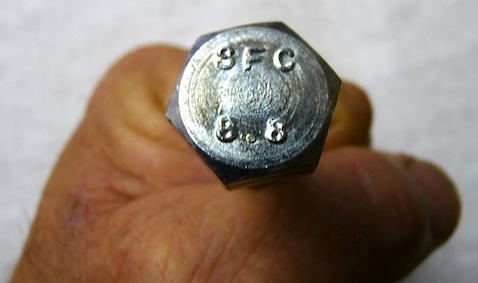
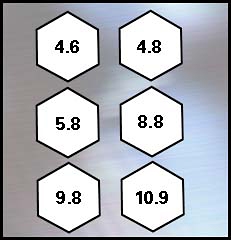


This photo shows the difference in appearance between
the head of a stainless-steel carriage bolt and a zinc carriage bolt.

This photo shows a plastic-lined lock-nut compared with a conventional hex-head nut.
LAG SCREWS

Lag screws are like heavy screws with hex heads.
FASTENER IDENTIFICATION
Nails

This is a cut nail. As an older style, they’re not used much anymore,
but you will see them used in older homes.

The photo above compares a galvanized finish nail above a stainless-steel siding nail.
Below are three views of nails commonly used for fastening metal connectors.


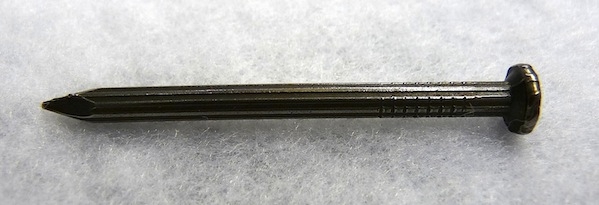
A masonry nail

This photo shows a TimberLok® screw designed for use
with log and timber-framed homes.
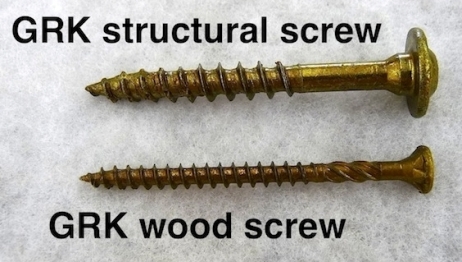
The photos above and below show structural and wood screws manufactured by GRK.

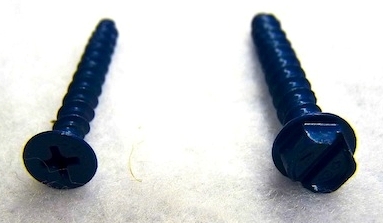
Screws designed for use in masonry are often colored blue.
NAIL GUNS & NAILS
The concern with fasteners installed with nail guns is over-driving the nails that are used to fasten structural floor, wall and roof panels made of materials such as plywood. In these cases, it’s important that the nails not be over-driven.
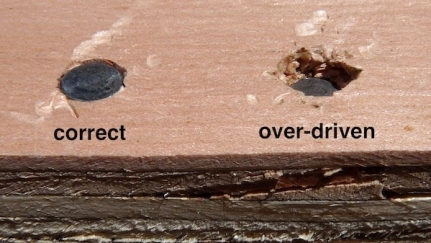
Over-driving nails (or driving them at an angle) reduces
the effective thickness of the panel by breaking through its veneer.

Driver-Depth Adjustment Devices
Many newer guns have driver-depth adjustment devices built into the trigger mechanism. On nail guns that lack this device, the depth of the driver may be regulated by adjusting the air pressure at the compressor. This is less accurate, since the density of wood will vary.
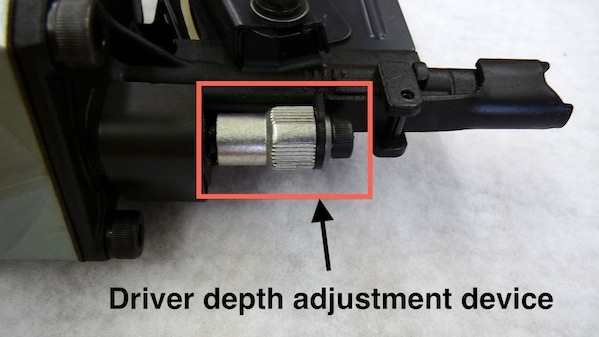
A newer gun with a driver-depth adjustment device

An older gun whose driver depth is regulated by air pressure
Gun Nails
Framing nails for guns typically come in strips. Here are a few examples.

Galvanized 12d

Bright, ring-shank 8d

Hot-dipped galvanized 6d
Staples


